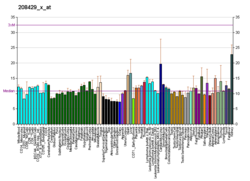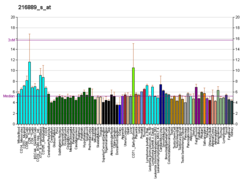Top Qs
Timeline
Chat
Perspective
Hepatocyte nuclear factor 4 alpha
Protein-coding gene in the species Homo sapiens From Wikipedia, the free encyclopedia
Remove ads
Hepatocyte nuclear factor 4 alpha (HNF4A) also known as NR2A1 (nuclear receptor subfamily 2, group A, member 1) is a nuclear receptor that in humans is encoded by the HNF4A gene.[5][6]
Remove ads
Function
HNF-4α is a nuclear transcription factor that binds DNA as a homodimer. The encoded protein controls the expression of several genes, including hepatocyte nuclear factor 1 alpha, a transcription factor that regulates the expression of several hepatic genes. This gene plays a role in development of the liver, kidney, and intestines. Alternative splicing of this gene results in multiple transcript variants.[7]
HNF4A is required for the PXR and CAR-mediated transcriptional activation of CYP3A4.[8] Genetic mutations in the HNF4A gene can influence the activity of HNF4α's downstream proteins such as CYP2D6, in vitro and in vivo.[9][10]
The alkaloid berberine upregulates HNF4A expression.[11]
This gene plays a pivotal role in the expression and synthesis of SHBG, an important glycoprotein made primarily in the liver,[12] which in addition to lowering insulin-resistance also reduces levels of free Estrogen as-well as prolonging the half-life of testosterone.[citation needed]
Function of HNF4A gene can be effectively examined by siRNA knockdown based on an independent validation.[13]
Remove ads
Clinical significance
Mutations in the HNF4A gene are associated with a form of diabetes called maturity onset diabetes of the young (MODY),[14] specifically MODY 1. At least 56 disease-causing mutations in this gene have been discovered.[15]
Increased amplification of hepatocyte nuclear factor 4 alpha has been observed in colorectal cancer.[16]
It has also associations with the appearance of Fanconi syndrome phenotypes which occurs due to a missense mutation of the gene.[17]
Remove ads
Interactions
Hepatocyte nuclear factor 4 alpha has been shown to interact with:
See also
References
Further reading
External links
Wikiwand - on
Seamless Wikipedia browsing. On steroids.
Remove ads








